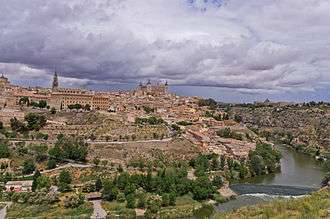Convento de Santa Clara la Real, Toledo
The Convento de Santa Clara la Real is a convent of the Poor Clares located in the city of Toledo (Castile-La Mancha, Spain). The present convent was founded in the middle of the 14th century by the Toledan lady María Meléndez, and is located near other monasteries like the monastery of Santo Domingo el Real and the one of the Convent of Capuchins of Toledo.
At the beginning of the 13th century, the kingdoms of the Iberian peninsula - Aragon (James), Castile (Alfonso VIII and Ferdinand III), Portugal and Navarre (Sancho el Fuerte) - prepared the so-called "Western Crusade" in which, in addition, Franks and Bretons took part. People and lands of the Spanish kingdoms lived the full conquest, which determined in the peninsula a special religious spirituality.[1]
The first missionary journey from Saint Francis to the Peninsula, as a result of many Franciscan foundations throughout the territory, so much so that in the General Chapter of Assisi (1217) the Franciscan Province of Spain is established. The Friars Minor, in order to carry out their work, came before the authority - civil and ecclesiastical - with the "apostolic letters" and their simple poverty. In each city: they evangelize, found a convent of the Order and collaborate effectively to prepare the spirit of religious crusade, in aid of the monarchs. Its charismatic way of life, awakened in the people, already sensitized in their struggle for faith, a desire for evangelical conversion, with such a deep spirituality that even reached the Crown: Ferdinand III of Castile (1217-1252), was great Protector of the Order, and it seems that he was a member of the Third Franciscan Order (Secular Franciscan Order.) The King died in 1252, a year before Santa Clara.[2]
It is Spain, after Italy, the first to receive the Poor Sisters - "Poor Ladies Cloistered" - just as before with the Friars Minor, since the Franciscan ideal attracted men and women alike. The origin of the Poor Clares in Spain dates back to the third decade of the 13th century, around 1227 (during the life of Saint Clare), with a strong expansion throughout the century, with the foundation of a total of fifty monasteries of Damianites in all Spain.[3]
History
The primitive convent of Santa María and San Damián of Toledo
The first Clares who settled in Toledo, even in the life of St. Clare of Assisi herself, were known at that time, as in the rest of Europe, as Dianians, "in memory" or honor of the first place where the San Damiano convent of Assisi had been established, and settled in the outskirts of Toledo, in the district or valley of Santa Susana, where the Seismological Institute of Toledo and the Santa Casilda Asylum are located, since the Toledan jurisdiction ordered that no monastery or convent be established in the interior of the city, due to the scarcity of urban land and the massive agglomeration of its inhabitants.
The Danaanites were ruled in Toledo by the Rule of Saint Benedict and were spiritually directed by the Franciscans of the city, although, as the historian María Luisa Pérez de Tudela pointed out, lived according to the way of life of Saint Clare. In addition, that primitive convent was placed under the invocation of Saint Mary and Saint Damian, and although some authors point out that it was founded around 1250 with the permission of the famous archbishop of Toledo, Rodrigo Jiménez de Rada, who was present in the Battle of Las Navas de Tolosa, published in 1212, the historian Pérez de Tudela pointed out that in case of having been founded during the mandate of this prelate it would have been in 1247, that was the year in which the archbishop died abroad.[4]

The foundation of the convento de Santa María y San Damián of Toledo was confirmed in 1254 by a bull by Pope Innocent IV, and the historian Pérez de Tudela pointed out that the first document in which the convent is mentioned is at the time is in the testament granted in 1248 by the Archbishop Juan de Medina de Pomar, who succeeded Rodrigo Jiménez de Rada at the head of the archdiocese of Toledo, and where, along with some convents located in the interior of the city of Toledo, is referred to another of the minor friars located outside its walls: "et uni quos est extra muris, quod est Ordinis Minorum", which shows according to the historian that in 1248 the Poor Clares were already established in the Valley of Santa Susana, where they lived:
With a life in closure, poverty, prayer, chastity, abstinence and silence. Life that became extremely heroic, especially in the last decade of the period, during which, they were always threatened and in danger; Firstly because of the plague of 1348 and later by the disorders of the civil war (1351-1369), as a result of which, the alfoz of Toledo, was a witness and suffered from fences, galloping warriors and looting.
In 1345, during the last period of the reign of Alfonso XI of Castile, that died by the bubonic plague while beleaguering Gibraltar in 1350, a new Ordinances for the city of Toledo were drafted in which were forbidden for anyone to live outside its walls, but Pérez de Tudela stated that the Toledo claresses could not comply with this provision because of their extreme poverty and their lack of resources to move to the interior of the walled enclosure, and were forced to continue bearing the inconveniences derived from the fact of residing outside the walled. Nuns remained in that place for more than a hundred years.
The convent of Santa Clara of Toledo
_01.jpg)
In the middle of the 14th century a lady of the Toledan nobility, María Meléndez, who belonged to a Mozarabic family and was married to Suer Téllez de Meneses, Toledo's chief constable, began to take the first steps towards the foundation of a convent of Poor Clares in Toledo. This lady was the Alfonso Díaz and Teresa López's daughter and Diego Alfonso de Toledo's sister, and June 22 of 1340, year in which according to the historian Pérez de Tudela began to form the foundation of the convent, King Alfonso XI authorized the María Meléndez' brother to untie and exchange with her the "Big Houses" that she had in the collage of San Vicente of Toledo and that she had received from her grandfather Alfonso Díaz by means of majorat, by any other inheritance whose cost of maintenance was less elevated.[5]
In 1360, Suer Téllez de Meneses, the María Meléndez' husband, died and the historian María Luisa Pérez de Tudela said that the first "legal act" of the foundation of the convent of Santa Clara the Real took place the August 31 of 1368, during the Castilian Civil War, when María Meléndez donated to the Damianites nuns of Toledo and to its abbess Sancha Alfonso the houses of the city of Toledo where the founder lived along with their "inheritances et with cubas and the wineries and tinajas" so that in them they could establish a new convent, and on January 20, 1370, almost two years later, María Meléndez acquired for the convent half of some houses that were next to it and that belonged to "Habibi mora".
In 1370 the existence of the convent of Santa Clara de Toledo in the collage of San Vicente already appears in a document, and that same year the founder, María Meléndez, took the habits and professed like religious in the same, happening to be, as it indicated Pérez de Tudela, "one more" of the nuns of the convent, as it is recorded in several documents issued between 1373 and 1375, the latter year in which the abbess ceased to be mentioned in the same ones.

On June 27, 1371, Pope Gregory XI issued in Avignon the Bull Piis devotorum in the name of Gómez Manrique, archbishop of Toledo, authorizing María Meléndez to found in the city of Toledo a convent of Clarean nuns who should provide everything necessary so that thirty nuns could live in it, although the bull was also demanded that the church of the new monastery had bell tower and bells and that the temple had everything necessary for the cult, and the abbess Sancha Alfonso committed herself before the archbishop of Toledo in her own name and in that of her successors to pay the tribute of the Subsidio and of the parochial tenths.
In 1373 the convent of Santa Clara was canonically established, solemnly, by the deed of foundation granted by María Meléndez on June 13, by which ceded to that convent the houses it owned inside the walled city of Toledo and all its possessions so that the Clarisses could build a convent in that city with the capacity to lodge thirty nuns and a sufficient dowry so that the monastery could be maintained with its own rents. And on August 3 of that same year María Meléndez granted a new deed In Toledo, by which she expanded the foundational dowry she had given to the convent of Santa Clara on June 13.
Notes and references
- ↑ María Luisa Pérez de Tudela y Bueso. The Monastery of Santa Clara La Real de Toledo: study on a royal monastic encomienda, 1376-1779 (PDF). p. 100.
- ↑ María Luisa Pérez de Tudela y Bueso. The Monastery of Santa Clara La Real de Toledo: study on a royal monastic encomienda, 1376-1779 (PDF). p. 100.
- ↑ María Luisa Pérez de Tudela y Bueso. The Monastery of Santa Clara La Real de Toledo: study on a royal monastic encomienda, 1376-1779 (PDF). pp. 100, 101.
- ↑ The historian María Luisa Pérez de Tudela pointed out in 2002 that the bull given by Archbishop Rodrigo Jiménez de Rada to the foundation of the Convento de Santa María y San Damián of Toledo was preserved until recently in the archive of the convent, although at present it is no longer there.Cfr. Pérez de Tudela y Bueso (2002), p. 108.
- ↑ The plot that currently occupies the convent of Santa Clara la Real was extended when on October 8, 1358, several years before its founding, the founder María Meléndez acquired, still in the life of her husband and according to a document conserved in the file of that monastery, several houses that had belonged to "don Mohamed" in the collage of San Vicente of Toledo to a lady named Constanza, who was the Fernán Gómez' daughter and Diego García's wife, and who were next to those of a lady called "Doña Fátima". Cfr. Pérez de Tudela y Bueso (2002), pp. 122-123 and 710.
External links
| Wikimedia Commons has media related to Convento de Santa Clara la Real (Toledo). |

